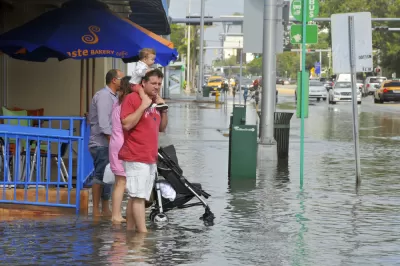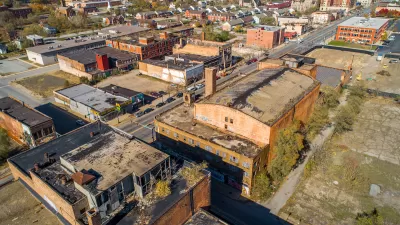More Americans are ignoring the realities of climate change emigrating—even as more and more climate refugees flee the damage.

[Updated September 1, 2021] Lily Katz and Sebastian Sandoval-Olascoaga share insight from a recent analysis by Redfin that finds Americans moving toward the devastation of climate change.
Among the key findings of the analysis, which uses data from the climate-data startup ClimateCheck to calculate climate risk: "The U.S. counties with the largest share of homes facing high heat, drought, fire, flood and storm risk saw their populations grow from 2016-2020 due to migration."
The report further describes that population growth as the result of positive net migration.
It's possible that in some cases, the heat in those fast-growing cities could be part of the reason housing prices are low.
The analysis also finds that the least risky locations, from a climate change standpoint, are experiencing population decline.
The 50 U.S. counties with the largest share of homes facing high heat risk saw their populations increase by an average of 4.7% from 2016 through 2020 due to positive net migration. Meanwhile, the 50 counties with the largest percentage of homes facing high drought, fire, flood and storm risk experienced average population growth of 3.5%, 3%, 1.9% and 0.4%, respectively, due to positive net migration.
Only the 50 counties facing increased storm risks grew during the same period—at a rate of 0.9 percent.
These large trends in migration are happening despite the nation's first climate refugees are already on the move at large scales. A paper published in September 2020 completed the largest ever mapping project to plot the high- and low-risk locations in the country in a future defined by climate change.
FULL STORY: More People Are Moving In Than Out of Areas Facing High Risk From Climate Change

Study: Maui’s Plan to Convert Vacation Rentals to Long-Term Housing Could Cause Nearly $1 Billion Economic Loss
The plan would reduce visitor accommodation by 25,% resulting in 1,900 jobs lost.

North Texas Transit Leaders Tout Benefits of TOD for Growing Region
At a summit focused on transit-oriented development, policymakers discussed how North Texas’ expanded light rail system can serve as a tool for economic growth.

Why Should We Subsidize Public Transportation?
Many public transit agencies face financial stress due to rising costs, declining fare revenue, and declining subsidies. Transit advocates must provide a strong business case for increasing public transit funding.

A Visual Celebration of Manhattan’s Chinatown Elder Community, Through Food
Lanterns, cafeteria trays, and community connection take center stage in this stunning photo essay.

How to Make US Trains Faster
Changes to boarding platforms and a switch to electric trains could improve U.S. passenger rail service without the added cost of high-speed rail.

Columbia’s Revitalized ‘Loop’ Is a Hub for Local Entrepreneurs
A focus on small businesses is helping a commercial corridor in Columbia, Missouri thrive.
Urban Design for Planners 1: Software Tools
This six-course series explores essential urban design concepts using open source software and equips planners with the tools they need to participate fully in the urban design process.
Planning for Universal Design
Learn the tools for implementing Universal Design in planning regulations.
City of Santa Clarita
Ascent Environmental
Institute for Housing and Urban Development Studies (IHS)
City of Grandview
Harvard GSD Executive Education
Toledo-Lucas County Plan Commissions
Salt Lake City
NYU Wagner Graduate School of Public Service





























